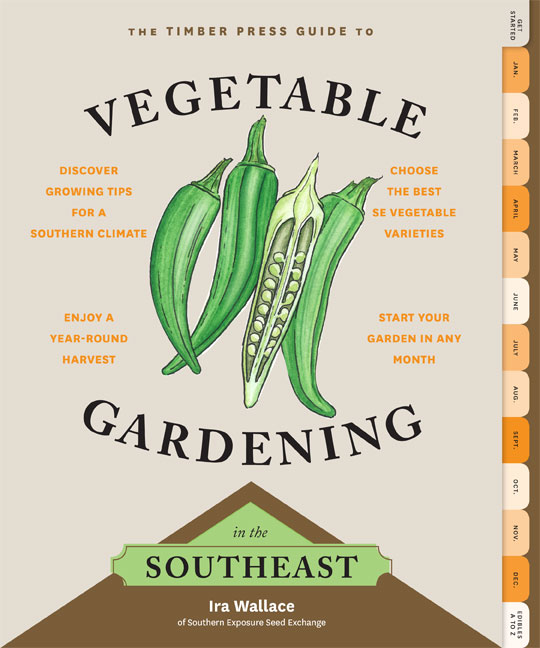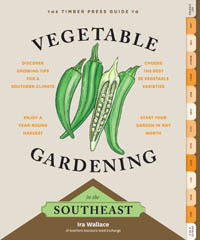 This book is valuable firstly to new vegetable gardeners and those moving to the Southeast. Of course, experienced gardeners always want to learn from each other, so I encourage anyone growing food in our region, or its neighbors, to get a copy. The writing and format are clear and accessible, the index is excellent, so you can quickly find the topic you want. The scale is backyard, not farm. That said, this book could also be useful for new farm interns learning crop basics, timing, and how things are done without fancy equipment. It has the advantage of clearly setting out the basic information without being overwhelming.
This book is valuable firstly to new vegetable gardeners and those moving to the Southeast. Of course, experienced gardeners always want to learn from each other, so I encourage anyone growing food in our region, or its neighbors, to get a copy. The writing and format are clear and accessible, the index is excellent, so you can quickly find the topic you want. The scale is backyard, not farm. That said, this book could also be useful for new farm interns learning crop basics, timing, and how things are done without fancy equipment. It has the advantage of clearly setting out the basic information without being overwhelming.
The Southeast has been “traditionally underserved†in terms of vegetable gardening books, so having this compilation of tips for our climate, the names of reliable regional varieties, and the encouragement to start in any month and harvest in every month, is valuable beyond price. There are great gardening writers elsewhere in this big country, but nothing beats learning from someone who really knows the territory. Ira learned gardening in her grandmother’s yard in Florida, and has grown food in Virginia for many years. It is hard to translate northern books which talk of ground frozen solid for months in winter, or curing onions out in the September sun. Beginners will have a much happier time starting out with a book written for the actual conditions they will encounter. Gardeners moving from other climate zones will get useful information about working with “the quirks of our climateâ€; fall gardening, winter gardening, hot weather crops like southern peas and okra. For instance, did you know why gardeners in hot climates don’t sow in hills? They dry out too much (the gardeners as well as the hills!).
This book is intended mostly for those in the lands where the American Holly grows. This is zones 6-9, with bits of 5 and 10: the Southeastern Coastal Plains, Piedmont, Appalachians, Interior Plateau and Ozarks. Winters are temperate, summers are hot and humid, and there is a wide range of seasonal crops. We need to start spring crops early, to get a harvest before temperatures heat up; we need to add organic matter frequently, as it burns up fast in hot humid conditions; we need to know about shading.
The Gardening 101 section includes many helpful tips on soil tests, garden planning and rotations and cover crops. There are lists of crops by season and by ease of growing in our climate. As the introduction says, “Happily, gardening is a year-round activity in our regionâ€, so there is a month-by-month section listing tasks and possibilities.
The Month-by-month section includes a To Do page for each month with panels on Plan, Prepare and Maintain, Sow and Plant, and Fresh Harvest. There is also a Skill Set panel each month covering topics such as making compost, setting up drip irrigation, building shade structures. Each month has a theme: Sowing Seed Indoors for February, Beating the Heat in July. The tone is encouraging and helpful for beginners and climate migrants alike.
My one quibble is that the drawings don’t always seem to exactly fit the text, and I wish there could have been some photos. Luckily, Ira is from Southern Exposure Seed Exchange and their website www.southernexposure.com has plenty of photos of crops in action and includes a sun symbol for varieties especially suited to the Southeast.
There is a nice description of working against the shortening days and cooling temperatures of fall to get crops established in the “living refrigerator†outdoors – filling it up to draw from later. Plan for crops to mature in late November, before growth slows right down. There are a lot of critters out there, though, so bring in what you can for storage. Also, plan to have some crops reach half-size, be protected over winter, then rapidly grow in early spring for first harvests of the new growing season.
Part 3 of the book is an A to Z of crops, starting with two Planting and Harvesting Charts, one for the Upper South and one for the Lower South. These cover 38 crops or groups of closely-related crops. Then each crop has around one page of details, divided into paragraphs on Growing, Harvesting, Varieties and Seed Saving.
The Resources section includes seed and plant suppliers, community organizations, weather and climate resources, companies selling tools and supplies, soil testing services and more good books (blush, including mine). There is a Glossary, to demystify any terms you don’t know – soon you will!
If you live in the Southeast and are new to growing food here, you’ll learn a lot from this book and its clearly arrayed information. If you live around the Southeast, you’ll probably also learn some tips (think of Pennsylvania as the “Upper Southeastâ€!). If you’re a farmer with new interns about to arrive, get this book for your library. If you’re an experienced vegetable grower in our region, take a look too – I bet you’ll find some new ideas.







